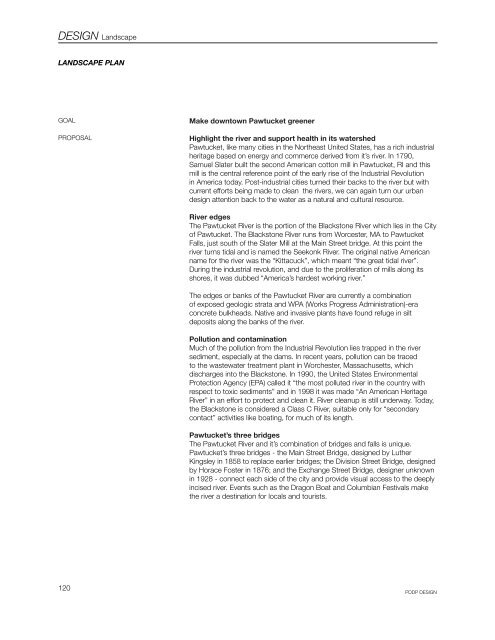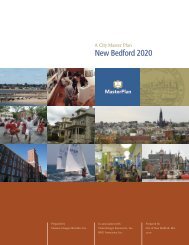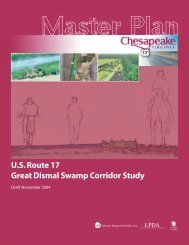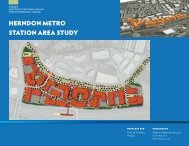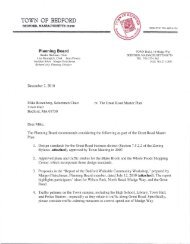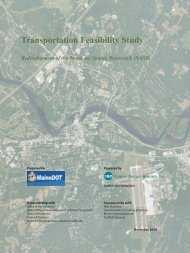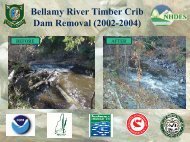PAWTUCKET DOWNTOWN DESIGN PLAN FINAL ... - VHB.com
PAWTUCKET DOWNTOWN DESIGN PLAN FINAL ... - VHB.com
PAWTUCKET DOWNTOWN DESIGN PLAN FINAL ... - VHB.com
You also want an ePaper? Increase the reach of your titles
YUMPU automatically turns print PDFs into web optimized ePapers that Google loves.
<strong>DESIGN</strong> Landscape<br />
LANDSCAPE <strong>PLAN</strong><br />
GOAL<br />
PROPOSAL<br />
Make downtown Pawtucket greener<br />
Highlight the river and support health in its watershed<br />
Pawtucket, like many cities in the Northeast United States, has a rich industrial<br />
heritage based on energy and <strong>com</strong>merce derived from it’s river. In 1790,<br />
Samuel Slater built the second American cotton mill in Pawtucket, RI and this<br />
mill is the central reference point of the early rise of the Industrial Revolution<br />
in America today. Post-industrial cities turned their backs to the river but with<br />
current efforts being made to clean the rivers, we can again turn our urban<br />
design attention back to the water as a natural and cultural resource.<br />
River edges<br />
The Pawtucket River is the portion of the Blackstone River which lies in the City<br />
of Pawtucket. The Blackstone River runs from Worcester, MA to Pawtucket<br />
Falls, just south of the Slater Mill at the Main Street bridge. At this point the<br />
river turns tidal and is named the Seekonk River. The original native American<br />
name for the river was the “Kittacuck”, which meant “the great tidal river”.<br />
During the industrial revolution, and due to the proliferation of mills along its<br />
shores, it was dubbed “America’s hardest working river.”<br />
The edges or banks of the Pawtucket River are currently a <strong>com</strong>bination<br />
of exposed geologic strata and WPA (Works Progress Administration)-era<br />
concrete bulkheads. Native and invasive plants have found refuge in silt<br />
deposits along the banks of the river.<br />
Pollution and contamination<br />
Much of the pollution from the Industrial Revolution lies trapped in the river<br />
sediment, especially at the dams. In recent years, pollution can be traced<br />
to the wastewater treatment plant in Worchester, Massachusetts, which<br />
discharges into the Blackstone. In 1990, the United States Environmental<br />
Protection Agency (EPA) called it “the most polluted river in the country with<br />
respect to toxic sediments” and in 1998 it was made “An American Heritage<br />
River” in an effort to protect and clean it. River cleanup is still underway. Today,<br />
the Blackstone is considered a Class C River, suitable only for “secondary<br />
contact” activities like boating, for much of its length.<br />
Pawtucket’s three bridges<br />
The Pawtucket River and it’s <strong>com</strong>bination of bridges and falls is unique.<br />
Pawtucket’s three bridges - the Main Street Bridge, designed by Luther<br />
Kingsley in 1858 to replace earlier bridges; the Division Street Bridge, designed<br />
by Horace Foster in 1876; and the Exchange Street Bridge, designer unknown<br />
in 1928 - connect each side of the city and provide visual access to the deeply<br />
incised river. Events such as the Dragon Boat and Columbian Festivals make<br />
the river a destination for locals and tourists.<br />
120<br />
PDDP <strong>DESIGN</strong>


